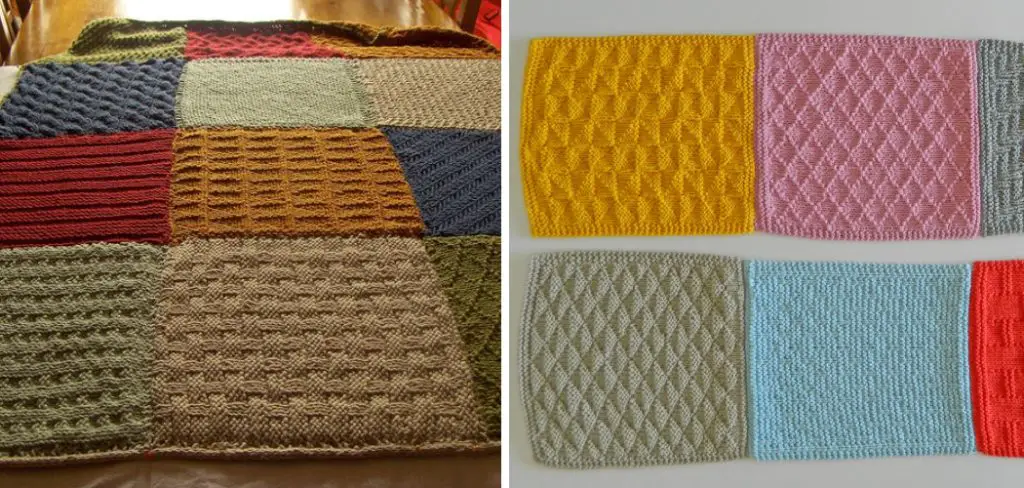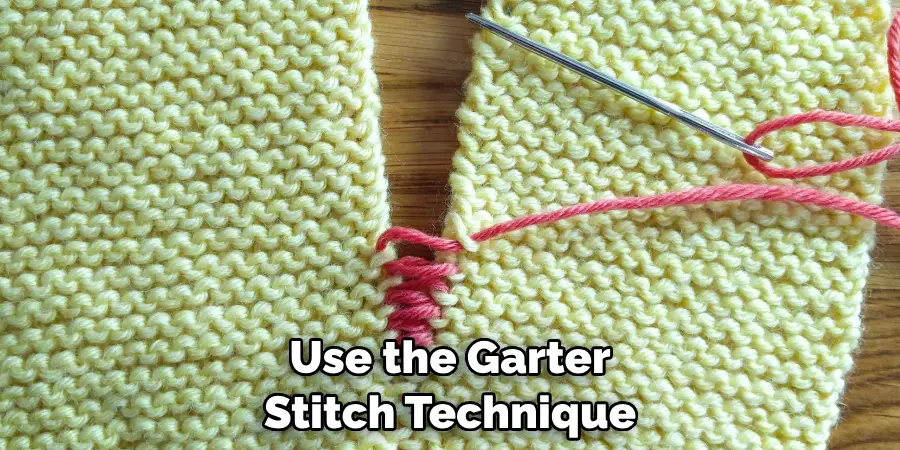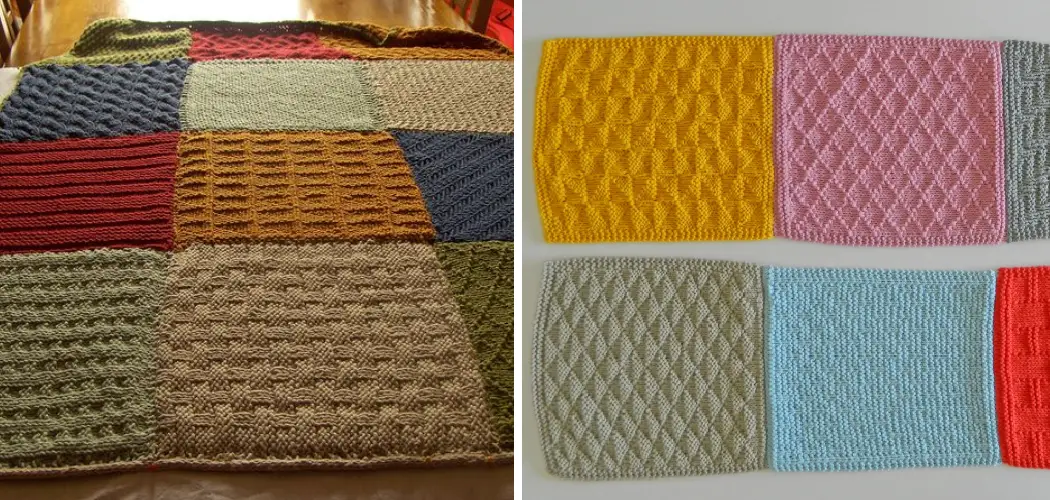Blocking a knitted blanket is a transformative step that brings your project to its full potential, ensuring impeccable stitches and a polished finish. Whether you’ve meticulously crafted a delicate lace design or worked on a cozy textured piece, knowing how to block a knitted blanket is essential for achieving a professional result.
In this comprehensive guide, we’ll delve into the art of blocking, unraveling the techniques and tools required to shape and refine your blanket. From preparing the blocking surface to determining the right level of moisture, we’ll explore the step-by-step process that will enhance the drape, evenness, and overall aesthetics of your masterpiece.

Whether you’re an experienced knitter seeking to perfect your work or a newcomer eager to elevate your skills, join us as we unravel the world of blanket blocking, offering insights that will empower you to create blankets that are as stunning as they are comfortable.
What Is Blocking in Knitting and Its Benefits?
Blocking is an optional but often essential step in the crafting process of knitting a blanket. Blocking opens up stitch patterns, helps even out tension, and gives finished projects a polished, professional look. Performing blocking can also be necessary for certain projects to properly function as intended.
When discussing blocking with knitters, it’s important to note that there is wet blocking and steam blocking. Wet blocking involves soaking the knitted item in cool water with a gentle cleaning agent before laying it out to dry.
Steam blocking, on the other hand, is done by lightly steaming the knitted item while it is laid out flat. Both types of blocking are used to even out stitches and create symmetry between horizontal and vertical edges.
Benefits of blocking a knitted blanket include improved stitch definition, maintaining shape and size uniformity, and preserving the integrity of the piece. Blocking also eliminates puckering and gives your finished craft an airy or light feel. The edges of a blocked knitted item will be much smoother than that of one that is not blocked.
Importance of Blocking a Knitted Blanket for Finishing and Appearance
Blocking a knitted blanket is an important step in finishing your project. It not only ensures you maximize the size of your knit, but also enhances its overall appearance. By blocking, you can make sure that the pattern and shape of your knitted fabric matches exactly what you pictured when working on the project.
Knowing how to block a knitted blanket is essential for any knitter. Blocking is the process of pinning out your knit and then steaming or wetting it, which encourages fibers to expand and lie flat as well as hold their shape. When done correctly, blocking can enhance stitch definition and add body to a fabric, making the most of its features.

When blocking a knitted blanket, you need to make sure that you use the right tools. Having a quality blocking board is essential for maintaining the shape of your knit and keeping straight edges.
You’ll also want to have plenty of sturdy pins on hand, as well as steam or misting equipment. Make sure your steam iron has a good amount of pressure if using one and an adjustable nozzle when using a steamer.
10 Methods on How to Block a Knitted Blanket
1. Garter Stitch:
The simplest way to block a knitted blanket is to use the garter stitch technique. This method involves knitting the blanket in a series of alternating rows of knit and purl stitches. Once the blanket is finished, simply wet it with cool water and gently stretch it out into shape before allowing it to dry completely.
2. Blocking Mats:
Blocking mats are an effective tool for blocking knitted blankets. These mats are designed to provide even tension when stretching the fabric, which helps ensure that all areas of the blanket are evenly blocked. To use this method, simply lay out the blocking mats on a flat surface and pin your knitted blanket onto them in its desired shape. Then allow it to dry completely before removing the pins.
3. Steam Blocking:
Steam blocking is another effective way to block a knitted blanket. This method involves using steam from an iron or steamer to dampen the fabric, which helps soften and relax the fibers making them easier to stretch out into shape.

To steam block your knitted blanket, simply place it on a flat surface and press down with your iron or steamer until it has been dampened throughout all layers of fabric. Allow it to cool before adjusting its shape as needed, and then allow it to dry completely before storing or wearing it.
4. Soaking:
Soaking is one of the most traditional methods used for blocking knitted blankets as well as other garments made from natural fibers like wool or cotton. To use this method, simply fill a sink or basin with lukewarm water and add some gentle detergent if desired before submerging your knitted blanket in the water for several minutes until fully saturated.
Gently squeeze out any excess moisture before rolling up your garment in a towel and pressing down firmly until most of the moisture has been absorbed by the towel. Then lay out your garment on a flat surface and adjust its shape as needed before allowing it to air dry completely before storage or wear.
5. Washing Machine:
Another easy way to block your knitted blanket is by using your washing machine’s delicate cycle setting with cold water only (no detergent).
Place your garment inside an appropriate-sized mesh bag or pillowcase first before placing it inside the washer so that you don’t risk any snagging during agitation cycles that could distort its shape while wetting it down evenly at the same time without having to soak manually beforehand as described above in Method 4 (soaking).
Once done, remove it from the washer carefully and adjust its shape as needed on a flat surface before allowing it to air dry completely prior to storage or wear afterward, too!
6. Pinning & Tacking:
Pinning & tacking can also be used when blocking knitted blankets too! This method involves placing pins along each edge of your garment into place while tacking down any loose areas that need extra attention, such as around armholes etc. Using thread in order to secure them properly first – then once everything looks good, just leave pinned & tacked overnight until fully dried!

7. Weights & Gravity:
Weights & gravity can also be used when blocking knitted blankets too! This method involves weighing down each area of your garment with heavy objects such as books or weights (or even people!) so that they stay put while drying overnight – just make sure not to place anything too heavy on top otherwise you risk distorting/stretching out certain parts more than others which could end up looking uneven afterward!
8. Ironing Board Method:
The ironing board method is another great way for blocking knitted blankets, especially if you don’t have access to other tools/equipment mentioned above, like blocking mats etc…
Simply lay out your garment over an ironing board covered with thick towels underneath first – then use steam from an iron (or steamer) over each area gently until dampened but not overly saturated – finally adjust its shape accordingly while still damp & let air dry fully afterward too!
9. Stove Top Method:
The stovetop method is another popular way for quickly blocking large-sized items such as blankets without having access other tools/equipment mentioned above like blocking mats etc.
Simply lay out your item over two stovetop burners set at medium heat – then use steam from boiling water placed over each side gently until dampened but not overly saturated – finally adjust its shape accordingly while still damp & let air dry fully afterward too!
10. Spray Bottle Method:
The spray bottle method is great for small-sized items such as baby sweaters etc. Just fill up an empty spray bottle with lukewarm water – then spritz lightly over each area, being careful not to saturate too much (as this may cause shrinking) – finally, adjust its shape accordingly while still damp & let air dry fully afterward.
Conclusion
Blocking with pins and wires is a great way to accentuate the detail of your knitted blanket. Not only does this process give finished pieces an even, crisp look, but it also provides structural stability to your work.
Blocking is a simple procedure and is easily done but can take more effort if precise measurements are desired. Having the right tools makes blocking your project much easier both in terms of time spent blotting, as well as accuracy.
Regardless of whether you’re making a traditional knitted afghan or a bigger and bolder cabled throw, blocking is the key to bringing out the fine details that will give your artistry increased presence. If you’ve been wondering how to block a knitted blanket, you now have an answer!
Hopefully, this article gave you some helpful tips about how to block a knitted blanket successfully, so now that you have the proper knowledge on how to get the job done, why not give it a try today?

